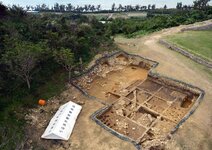Archaeologists have found ancient Roman coins buried in the ruins of a 12th-century castle in Okinawa, and no one knows how they got there.
Hiroki Miyagi, an archaeologist at Okinawa University who helped analyze the find, said that there was no evidence that there was trade between the Ryukyu Kingdom and the West. But, he added, “We know from documents and pottery shards that there was extensive trade with China and Southeast Asia from the 14th to the 19th century.”
The coins, he suggested, arrived in Okinawa via China. “There is a possibility that Chinese traders got the coins from Muslim traders,” Dr. Miyagi said.
The Japan Times reports that an X-ray analysis has found that the coins depict a soldier holding a spear and a portrait of Constantine the Great, a fourth-century Roman emperor.

http://www.nytimes.com/2016/10/04/science/japan-archaeology-roman-coins.html?_r=0
Hiroki Miyagi, an archaeologist at Okinawa University who helped analyze the find, said that there was no evidence that there was trade between the Ryukyu Kingdom and the West. But, he added, “We know from documents and pottery shards that there was extensive trade with China and Southeast Asia from the 14th to the 19th century.”
The coins, he suggested, arrived in Okinawa via China. “There is a possibility that Chinese traders got the coins from Muslim traders,” Dr. Miyagi said.
The Japan Times reports that an X-ray analysis has found that the coins depict a soldier holding a spear and a portrait of Constantine the Great, a fourth-century Roman emperor.

http://www.nytimes.com/2016/10/04/science/japan-archaeology-roman-coins.html?_r=0




